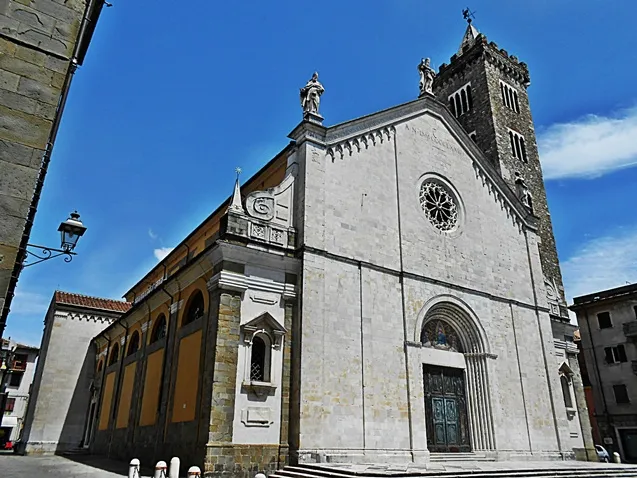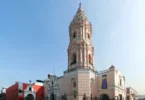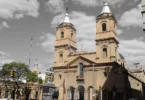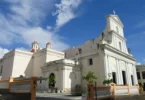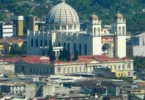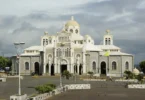Introduction
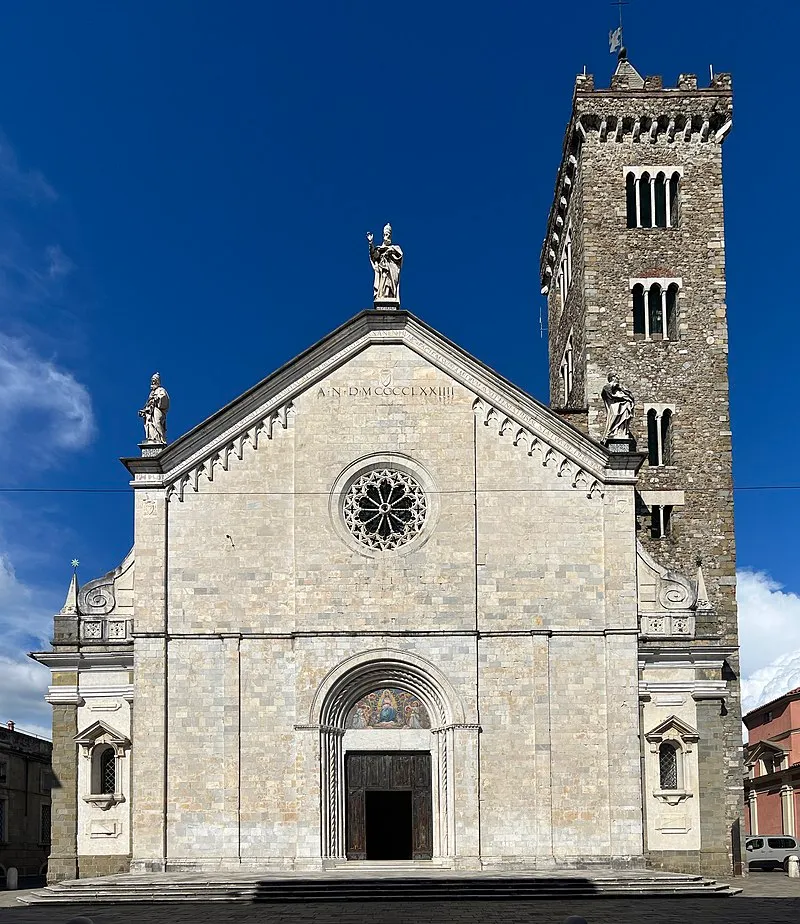
Sarzana Cathedral, officially known as Concattedrale di Santa Maria Assunta di Sarzana, is a prominent Catholic church located in Sarzana, Liguria, Italy. Situated in the heart of the town, between Piazza Niccolò V and Via Giuseppe Mazzini, the cathedral serves as a co-cathedral of the Diocese of La Spezia-Sarzana-Brugnato. It is dedicated to the Assumption of the Virgin Mary, a central event in Catholic theology that celebrates Mary’s ascent to heaven. The cathedral’s architectural style is a harmonious blend of Romanesque and Gothic elements, showcasing the building’s long construction period, which spanned from the early 13th century to the late 15th century. This unique combination of styles reflects the evolving artistic and cultural trends throughout its history, making it a valuable architectural and historical treasure.
The cathedral also holds significant religious relics, including a revered relic of St. Andrew, which attracts many pilgrims and visitors. In addition, it is home to a vial containing the Blood of Christ, symbolizing the deep spiritual significance of the church. Another notable artifact is the Romanesque Cross created by Maestro Guglielmo in 1138, an important piece of medieval religious art. In recognition of its historical and spiritual importance, Pope Pius XII elevated the cathedral to the status of a minor basilica in November 1947. This designation highlights the cathedral’s significance as a center of Catholic worship and its prominent role in the religious life of the region. Today, Sarzana Cathedral remains an important place of worship, art, and history, deeply cherished by both locals and visitors.
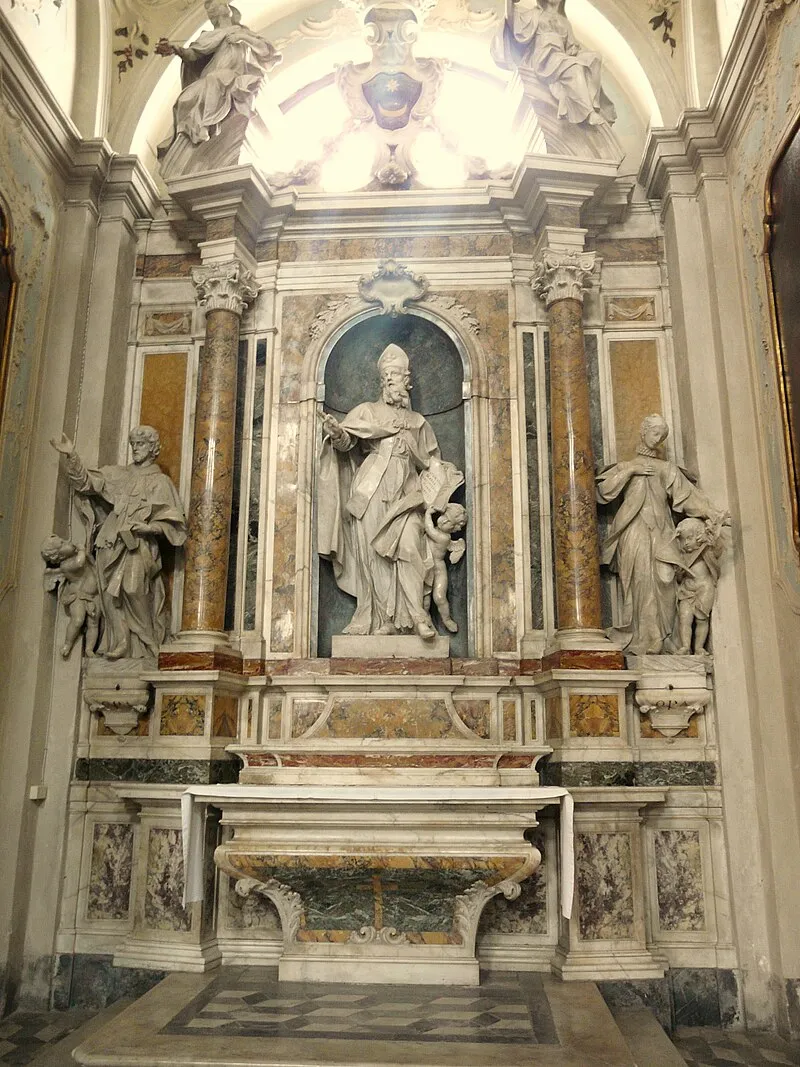
The Sarzana Cathedral, known as the Concattedrale di Santa Maria Assunta, is located in the center of the medieval village of Sarzana, Liguria, Italy. The current basilica-co-cathedral stands on the site of the original parish church dedicated to San Basilio. The earliest mention of this church dates back to November 11, 1148, in a papal bull issued by Pope Eugene III, confirming its importance as a place of worship. As Sarzana gained prominence in the region, particularly at the expense of the once-thriving Roman city of Luni, which was in decline due to malaria, the Canons of Luni petitioned Pope Innocent III for the transfer of the episcopal seat. The request was granted, and in 1204, Pope Innocent III officially transferred the seat of the diocese from Luni to Sarzana. However, the title of the bishopric remained associated with Luni. In exchange, Sarzana’s community pledged to construct a new cathedral and episcopal residence.
Rather than building an entirely new church, the decision was made to transform and expand the existing San Basilio parish church. This project began promptly, though it faced several interruptions and restarts, as documented in historical records. By the mid-14th century, the transformation was largely completed, and the church could be considered a cathedral, though the official recognition of Sarzana as the diocesan seat remained pending. This recognition began to take shape in 1447 when Tommaso Parentuncelli, from Sarzana, was elected Pope Nicholas V. However, it was not until 1465 that Pope Paul II formally transferred the episcopal title and associated rights from Luni to Sarzana, officially establishing the church of Santa Maria Assunta as the cathedral of the new Diocese of Luni-Sarzana. In the same period, the church’s interior decoration was completed, and the façade was finished in 1474 by the artist Leonardo Riccomanni of Pietrasanta.
The cathedral is built in the late Gothic Tuscan style, featuring a Latin cross plan with three naves separated by arches and columns. The design includes a large apse and two chapels, and the wooden roof consists of exposed trusses.
In the 17th century, the cathedral underwent further embellishments, with Baroque artistic influences shaping the side naves and apse. These enhancements were overseen by Francesco Antonio Milani, and new side chapels were added. The final decorative touches included the installation of three statues on the facade in 1735: Saint Eutychianus in the center, Pope Sergius IV on the left, and Pope Nicholas V on the right. Over the centuries, Sarzana Cathedral has been transformed into an architectural and religious symbol of the region, continuing to serve as a focal point of spiritual and historical significance.
Architecture of Co-Cathedral of Santa Maria Assunta, Sarzana, Italy
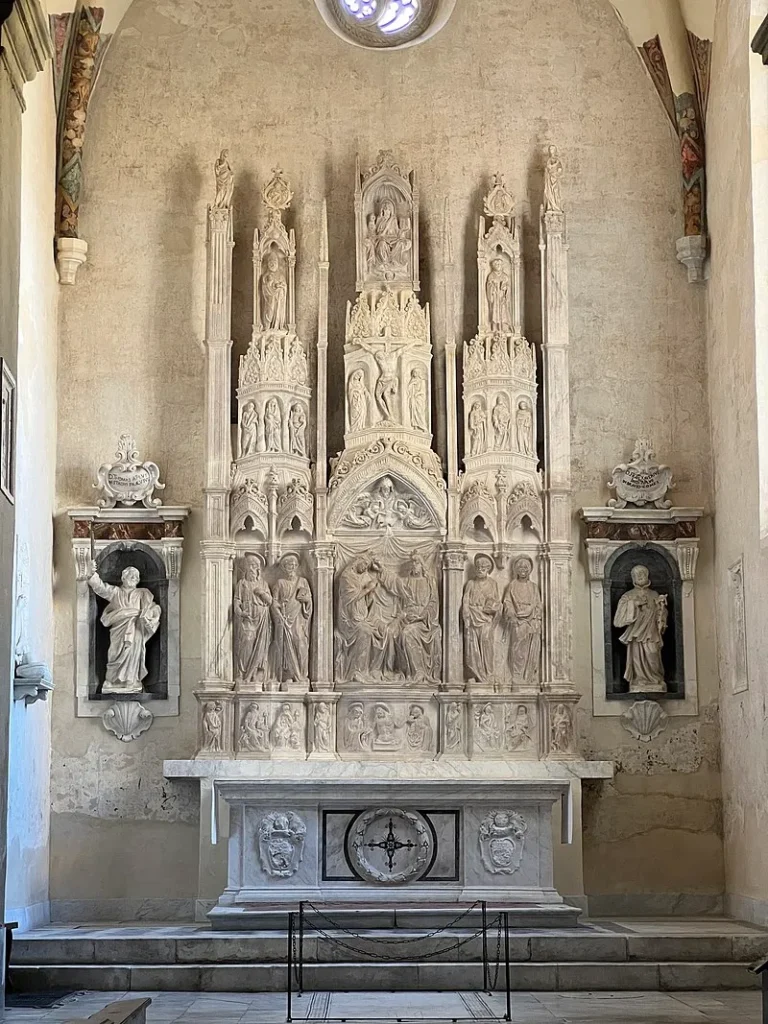
Architectural Style: Romanesque architecture, Gothic architecture, Baroque architecture, Renaissance architecture
External Features
Sarzana Cathedral showcases a blend of Romanesque and Gothic styles, with a remarkable façade and several significant architectural elements that reflect its long history of construction and embellishment. The church’s west front is composed of white marble, which adds to the grandeur of the building. The portal, completed in 1355, is flanked by two side blocks that were added in the 17th century. Above the portal, a small Gothic rose window adds a touch of elegance. The battlemented campanile, situated to the south, is the sole remnant of the ancient Pieve di San Basilio, a structure that once served as the parish church before the cathedral was constructed.
The cathedral’s ground plan follows the shape of a Latin cross, which is a traditional design for Christian churches. The nave is divided into three aisles by two arcades of widely spaced polygonal columns, each supporting high arches that create an expansive and open interior. The central nave leads to the choir and apse, while the side aisles terminate in chapels, all of which are crowned with cupolas. Along each of the side aisles, there are four chapels, and the short transept also contains a chapel at each wing. These chapels were added in the late 17th century and enhance the spiritual and architectural significance of the cathedral. The wooden panelled ceiling, crafted by Pietro Giambelli between 1662 and 1670, is another notable feature of the interior, with intricate carvings that add to the Baroque ambiance of the church.
Facade and Portal of Sarzana Cathedral
The façade of Sarzana Cathedral is a remarkable example of Romanesque architecture, characterized by its gabled structure, which was completed in 1355. The upper portion of the façade, which includes the white marble covering and the creation of the rose window, was finalized in 1474, largely due to the efforts of Cardinal Filippo Calandrini. An inscription on the façade honors this work, detailing Calandrini’s role in adding the upper section and adorning it with windows and statues, as commemorated by the year 1474. The portal, also completed in 1355, was designed by master Michelino de Vivaldo, as noted in the inscription on the architrave. This portal is further adorned by a mosaic lunette, which depicts the biblical event of the Assumption of the Virgin Mary into Heaven, surrounded by angels rejoicing in her exaltation.
Bell Tower
The bell tower, located adjacent to the cathedral, is a remnant of the ancient Pieve di San Basilio and provides a historical connection to the church’s origins. The bell tower is slightly set back from the façade and is designed with Guelph battlements and a pyramid-shaped spire. At the top of the spire is a wrought iron weather vane depicting an angel carrying the relic of the “Most Precious Blood”—a sacred object venerated by the faithful. The bell tower houses a concert of four bells, each made in different eras, the largest of which was recast in 1965. The oldest bell, dated 1579, is part of this collection, along with two smaller bells made by the Bozzoli founders of Genoa.
Interior Features
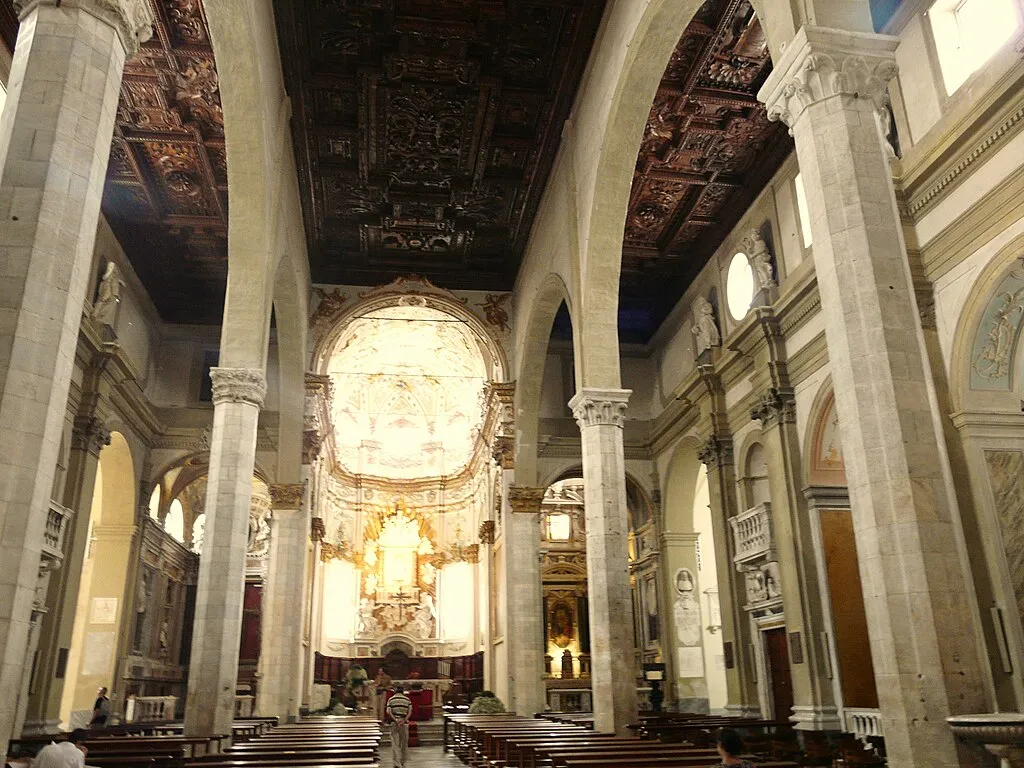
The interior of Sarzana Cathedral is a stunning example of Baroque style, with several elements of the original Gothic and Romanesque designs still visible. The church is divided into three naves, with the central nave being slightly higher and lacking windows. Large round arches supported by octagonal columns with sculpted capitals separate the naves. The wooden coffered ceiling, carved by Pietro Giambelli between 1662 and 1670, adds an exquisite touch to the space, with intricate carvings and decoration that enhance the cathedral’s Baroque atmosphere.
Along the side aisles, there are four chapels, with the last chapel in each aisle being deeper. These chapels are delineated by balustrades and contain altars made of polychrome marble. At the end of the right aisle is a chapel dedicated to the Most Holy Sacrament and the Most Precious Blood of Our Lord Jesus Christ. This chapel houses a valuable marble tabernacle and the relic of the Most Precious Blood. On the left side, the altarpiece of another chapel houses the famous Cross of Master Guglielmo, a significant historical artifact. At the end of the central nave is the deep semicircular apse, which houses the presbytery. This raised area contains the marble high altar in the center, surrounded by a wooden choir along the side walls. The ceiling of the apse is richly decorated with stucco and paintings, including a depiction of the Dove of the Holy Spirit in the center, symbolizing the presence of the Holy Trinity.
Relics
Sarzana Cathedral is home to several important relics, most notably a relic of Saint Andrew and the Blood of Christ, both of which are preserved in the Chapel of the Most Precious Blood (Cappella del Preziosissimo Sangue). This chapel is located to the south of the choir and high altar, and the relics are venerated by the faithful who visit the cathedral. The presence of these holy relics further elevates the spiritual significance of Sarzana Cathedral, making it a major site of pilgrimage and worship.
Works of Art in Sarzana Cathedral
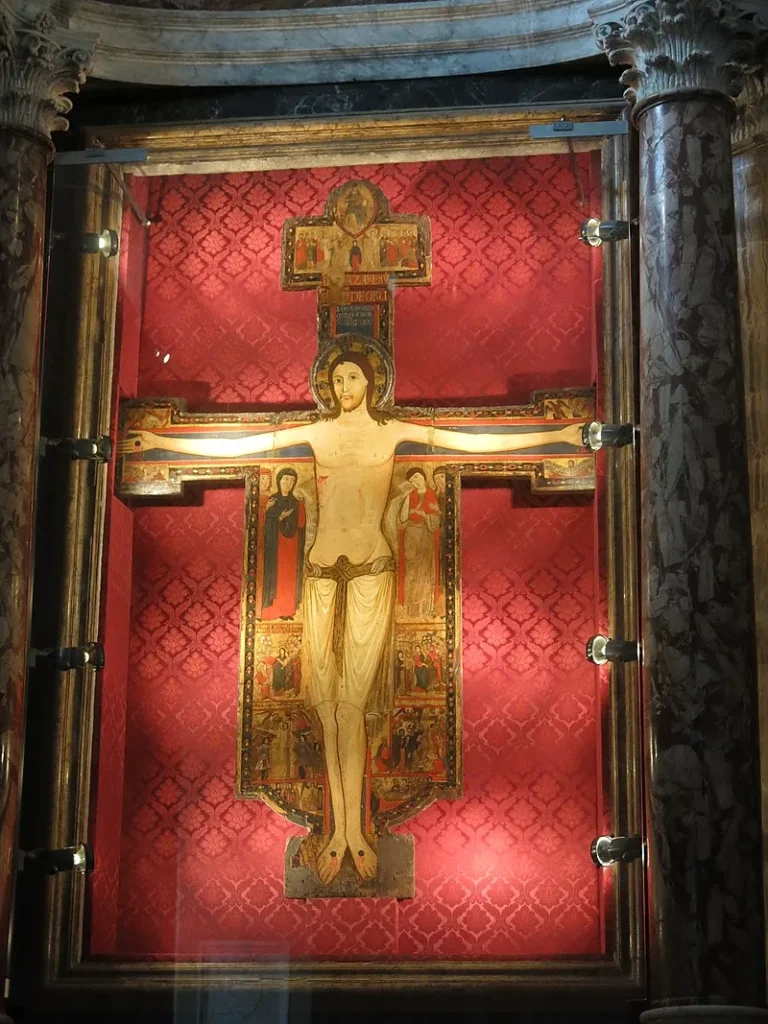
Cross of Maestro Guglielmo
Sarzana Cathedral is renowned for housing the oldest dated Tuscan crucifix, the Cross of Maestro Guglielmo, dated 1138. This Romanesque masterpiece is considered a central work of Romanesque painting, though parts of it have been retouched in the 14th century, particularly the face and body of Christ. The crucifix is an excellent example of the Christus triumphans type, a depiction of Christ as a triumphant, regal figure, which preceded the more human and suffering portrayal of Christus patiens. The crucifix is prominently displayed in the Baroque Chapel of the Cross, located to the north of the choir and high altar.
Notable Works of Art in Sarzana Cathedral
The Sarzana Cathedral is home to a vast collection of important artworks, showcasing a rich history of religious and artistic expression. Among its most notable pieces is the Cross of Maestro Guglielmo, the oldest dated Tuscan crucifix, crafted in 1138. This Romanesque painting exemplifies the iconography of the Christus triumphans, which represents a victorious and divine Christ before the more human and suffering image of Christus patiens became widely accepted. Additionally, the cathedral houses various works by Francesco Solimena, such as paintings depicting saints and religious themes. The cathedral’s altarpieces by the Riccomanni brothers, Leonardo and Francesco Riccomanni, showcase the Renaissance style, while a terracotta piece from the school of Luca della Robbia and marble busts of Pope Clement XI and Pope Innocent XI by Giovanni Baratta further enrich its collection. The apse’s Glory of the Virgin, designed in a Baroque style reminiscent of Bernini, is another magnificent work, and the Chapel of Saint Augustine features sculptures by the Carrarese artist Giovanni Antonio Cybei. In addition to these artworks, the cathedral holds sacred relics, including the Blood of Christ, which was brought to Luni in 742 and later transferred to Sarzana, as well as the hand and arm of Saint Andrew, a gift from Pope Gregory the Great in the 6th century. These relics, along with other significant paintings and sculptures, such as Domenico Fiasella’s works and Francesco Solimena’s canvas of Saints Pope Clement, Philip Neri, Lawrence, and John the Evangelist, make the cathedral a place of deep spiritual and artistic significance.
Pipe Organ
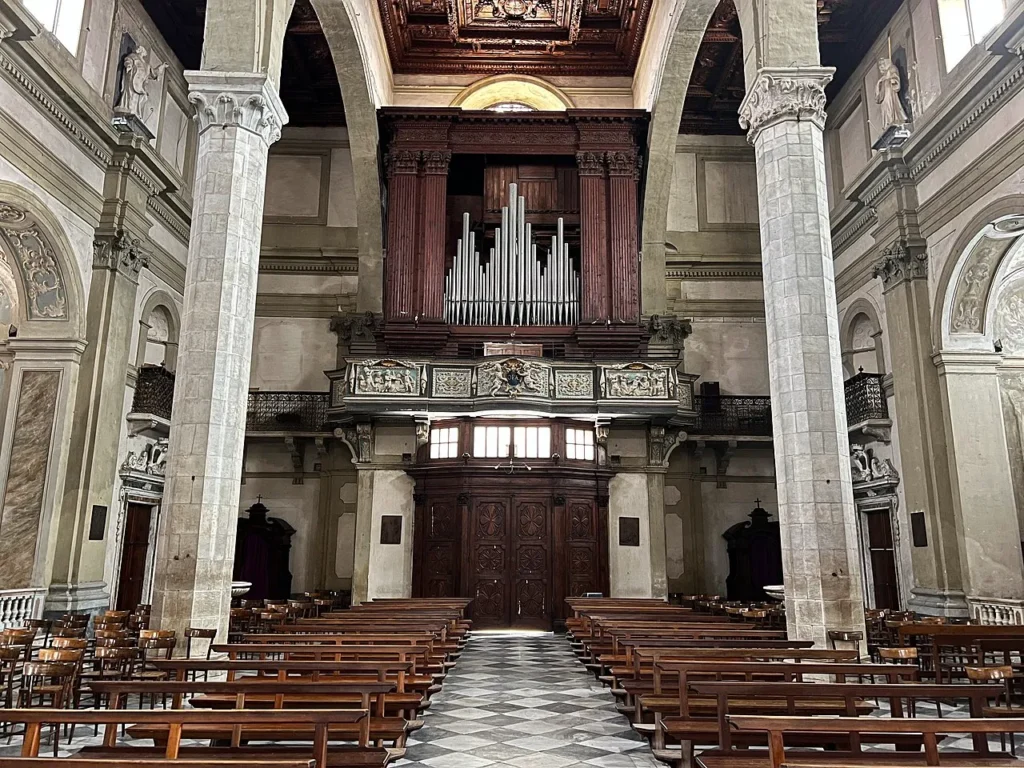
The Serassi pipe organ, located on the choir loft on the counter-façade, is an important historical instrument. Built between 1840 and 1842 (opus 561), it was restored in 1934 by the Parodi & Marin firm. The organ features a fully pneumatic transmission system. The console, also from the 1934 restoration, is located in the choir facing the nave. It has two keyboards, each with 58 notes, and a concave-radial pedalboard of 30 notes. The organ registers are controlled by rocker plates placed on the sides and above the keyboards. The organ is enclosed within a wooden case designed in the shape of a parallelepiped. The façade is surmounted by a high cornice supported by two pairs of fluted Corinthian pilasters, with the display consisting of 27 main pipes, arranged in three cusps of nine pipes each, each with mitre mouths.
Feast Day
Feast Day : 15 August
The feast day of the Co-Cathedral of Santa Maria Assunta in Sarzana, Italy is celebrated on August 15, in honor of the Assumption of the Virgin Mary. This feast commemorates the belief that Mary, the mother of Jesus, was taken bodily into heaven at the end of her earthly life. As the cathedral is dedicated to Santa Maria Assunta (Holy Mary’s Assumption), the day holds great significance for the faithful of Sarzana.
Church Mass Timing
Saturday : 5.30 PM.
Sunday : 8:30 AM, 10:00 AM, 11:30 AM, 6:00 PM
Church Opening Time:
Monday : 8:00 am – 12:00 pm., 3:00 pm – 6:30 pm.
Tuesday : 8:00 am – 12:00 pm., 3:00 pm – 6:30 pm.
Wednesday : Closed.
Thursday : 8:00 am – 12:00 pm., 3:00 pm – 6:30 pm.
Friday : 8:00 am – 12:00 pm., 3:00 pm – 6:30 pm.
Saturday : 8:00 am – 12:00 pm., 3:00 pm – 6:30 pm.
Sunday : 11:00 am – 11:30 am., 3:00 pm – 6:00 pm.
Contact Info
Address :
Via Nicolo V, 2, 19038 Sarzana SP, Italy.
Phone : +39 0187 620017
Accommodations
Connectivities
Airway
Co-Cathedral of Santa Maria Assunta, Sarzana, Italy, to Distaccamento Aeroportuale Sarzana Luni, Via Ghiarettolo, distance between 10 min (4.9 km) via Viale 25 Aprile.
Railway
Co-Cathedral of Santa Maria Assunta, Sarzana, Italy, to La Spezia Centrale Piazzale Medaglie d’Oro al Valor Militare, distance between 29 min (17.8 km) via A15 Autostrada della Cisa/A15.

